The Puerto Rico Vector Control Unit (PRVCU) is an initiative of the private, non-profit organization the Puerto Rico Science, Technology, and Research Trust. The PRVCU was established to leverage Puerto Rico’s capacity to control the Aedes aegypti mosquito, the vector for the diseases zika, chikungunya, and dengue in Puerto Rico. The unit focuses on strengthening the capacity for vector control in Puerto Rico as well as implementing vector surveillance, creating innovative information systems, carrying out vector control operations, and boosting community engagement through citizen mobilization and education programs.
PRVCU currently have over 1,000 mosquito traps deployed and they are using Workforce for ArcGIS with ArcGIS Enterprise 10.5.1 to plan and coordinate weekly maintenance, conduct vector control, and educate residents.
Workforce Projects
The PRVCU team is using Workforce for ArcGIS to plan and coordinate all vector control activities (deployment and maintenance of AGO surveillance of traps along with vector control). Workforce allows PRVCU to assign tasks to field workers and provides a solution for field workers to visualize their assignments on mobile devices. Once in location, Survey123 provides an easy to use experience for trap placement and data capture.
“Integration was important for us. Being able to create a workflow that maximized all our software capabilities, while minimizing the time it takes to capture the data needed. Workforce and Survey123 are key to our success, and have become a necessary tool for our daily operations. Currently we have complete integration of the daily operations between field and the mosquito identification laboratory teams, where we identify the mosquitoes by species, sub species and sex.” – Cesar Piovanetti, IT Architect and Spatial Platforms Engineer at PRVCU.
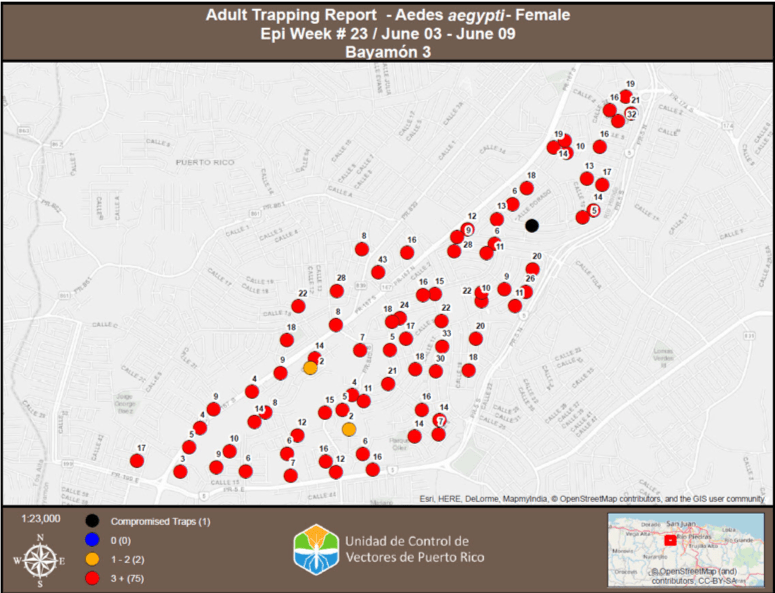
Each primary activity has its own Workforce Project:
Trap Deployment – this project is used for deployment of adult mosquito traps. Assignments are placed at a 250x 250 grid spacing where each assignment is placed at the center point of each grid. The assignment is used as a starting point for field workers to look for volunteers within each grid. The Community mobilization team is vital for selecting volunteers before deployment day. When volunteers are found, their locations are loaded to workforce along with the date and time agreed upon.
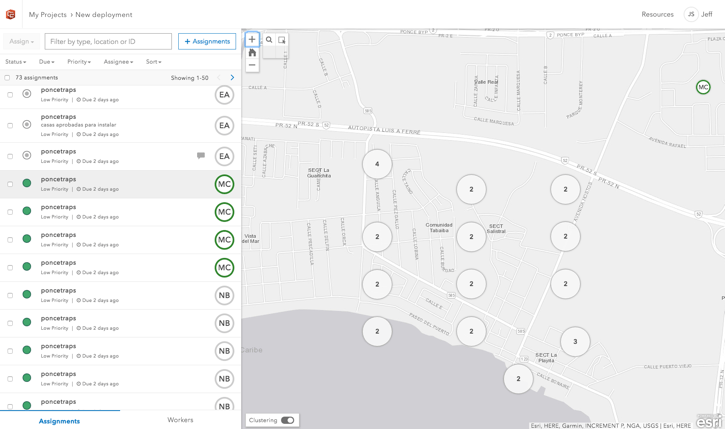
Mosquito Surveillance – How does it work?
The black container holds 10 liters of a water and hay infusion. The dark color of the trap and the odor from the infusion attracts female Aedes aegypti mosquitoes, looking for somewhere with water to lay their eggs. Mosquitoes enter the capture chamber but a screen prevents them from getting close to the water. Ready to lay their eggs female mosquitoes land on the sticky adhesive surface inside the trap and become stuck. Field technicians will collect the capture chamber once a week and take it to the laboratory where mosquitoes are then removed from the sticky paper, identified and counted.
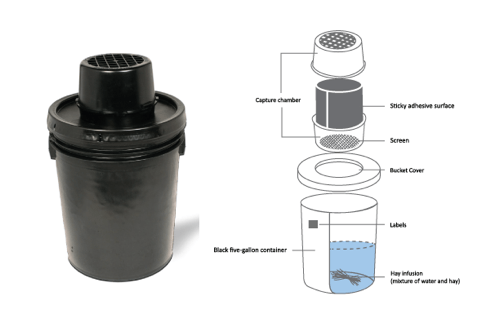
These traps do not contain insecticide and the PRVCU is currently not using them to control mosquito populations. This Project keeps track of the weekly maintenance work that must be done to each adult mosquito trap. Partial Maintenance is done once a week, and on the eighth week, full maintenance is performed. Full maintenance is comprised of cleaning the entire trap, changing the water, as well as the hay and mosquito glue used in the top capture chamber.
The day a trap is deployed, it has to be maintained 1 week later. Every morning, python maintenance script run through windows task scheduler, it queries, selects and assign traps that need to be maintained that day (before 5pm). If a trap does not receive maintenance that day, then it’s priority is elevated to high so that it can be completed the next morning. PRVCU uses a combination of due dates and priorities to manage the importance of work. This business logic is automated using python scripts and scheduled.
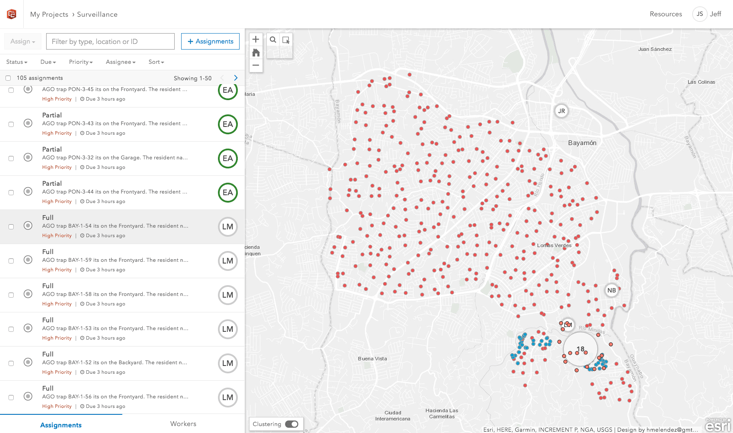
Below is a neighborhood view showing the density of assignments.
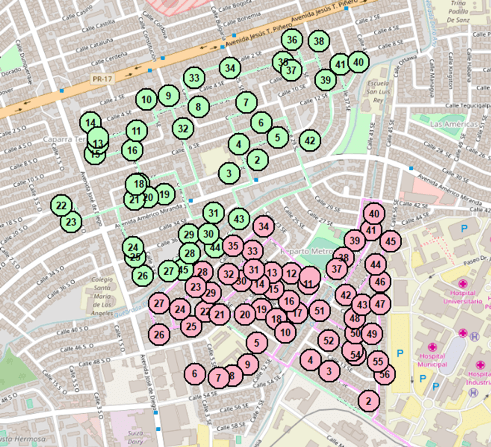
Vector Control – based on the results of weekly surveillance, the traps with the most mosquitos are selected to perform vector control. Vector control includes breeding site reduction, larvicide application on breeding sites, and education of residents on how to properly clean and remove mosquito breeding site locations. The selection process starts by buffering each trap, then selecting the homes that fall within each trap buffer. The trap with the most mosquitoes that week will have 1st priority, the homes that fall within that trap buffer are selected and loaded into Workforce as 1st priority.
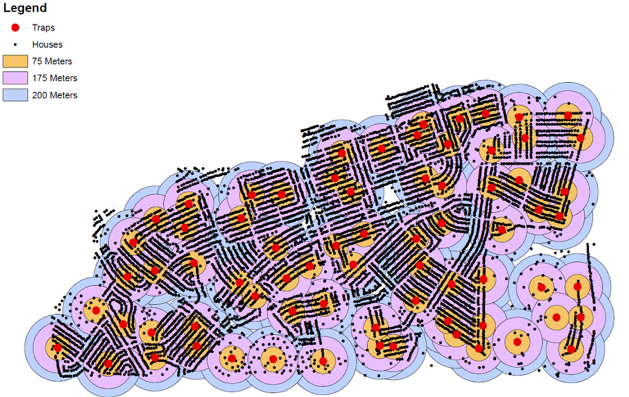
The Vector Control project runs on a weekly cycle. With advanced business logic in place using Azure SQL and ArcGIS API for Python, the unit is able to load all assignments with the desired priority, using the ID field is used to indicate the importance of work that should be completed.
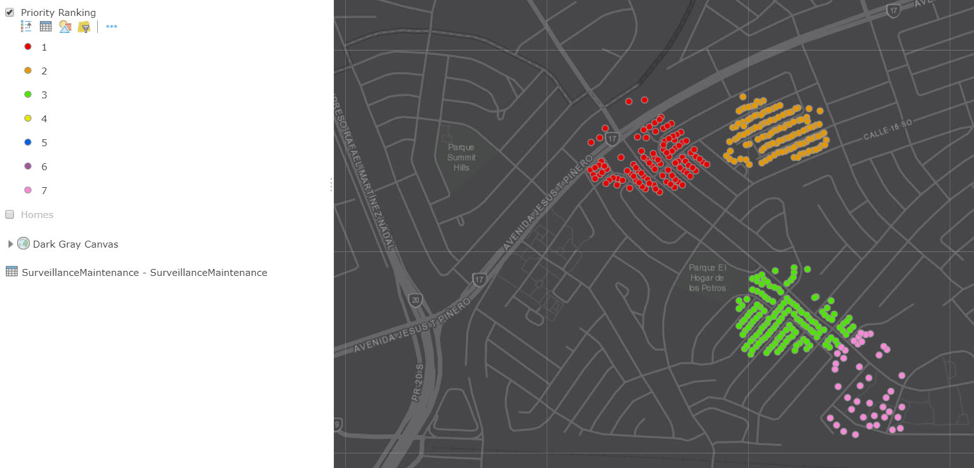
Weekly maintenance assignments cover an entire neighborhood as shown below.
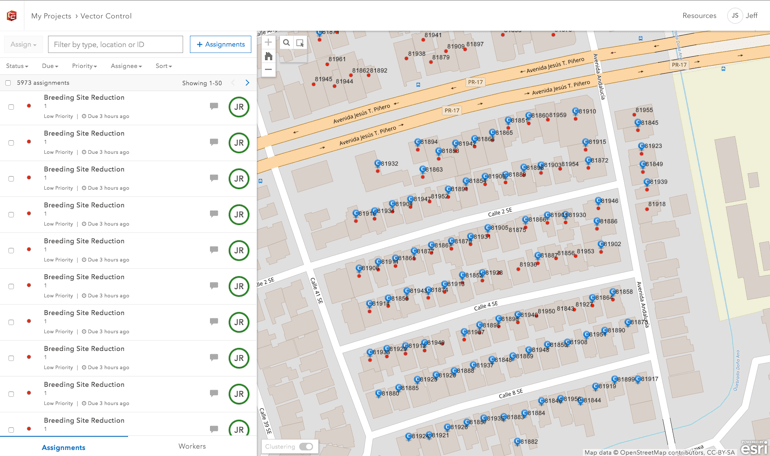
“Our mission is to protect the people of Puerto Rico from the Aedes aegypti mosquito, while educating and empowering everyone to dramatically and sustainably reduce mosquito populations across Puerto Rico. ArcGIS Enterprise, Workforce for ArcGIS, Survey123 and ArcGIS API for Python are critical to implementing a successful, integrated vector management (IVM) strategy at Puerto Rico Vector Control Unit.”
Combining vector surveillance and monitoring, vector control operations, and island-wide community engagement, education and mobilization programs, all of which implemented in partnership with other agencies (government and non-government) and communities across the island of Puerto Rico, PRVCU is preventing the spread of vector-borne diseases. For more information, please visit http://prvectorcontrol.org/home or write PRVCU at info@prvectorcontrol.org.
Commenting is not enabled for this article.